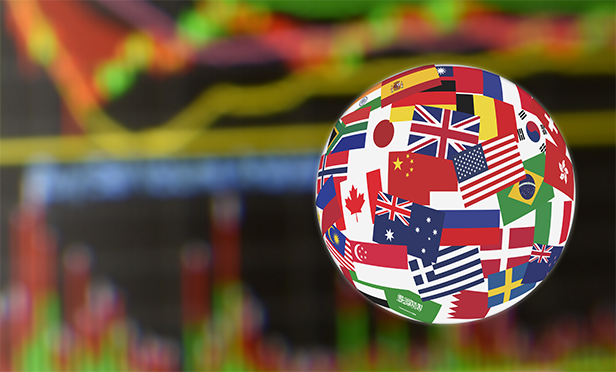
The global economy faces some serious headwinds this year,coming in the form of trade policy uncertainty, oil price volatility,monetary policy missteps by major players, andthe economic slowdown in China. These headwinds areexpected to cause turbulence for many countries, but especially foremerging markets.
|All that said, some emerging markets remain fertile for businessopportunities. According to a recent report from trade credit insurerAtradius, the most promising emerging markets in 2019 are Bulgaria,Indonesia, Vietnam, Peru, and Morocco. Indonesia, Vietnam, andMorocco also appeared on our 2018 list of promising emergingmarkets.
|To be considered “promising,” a market must demonstrate steady,accelerating growth in gross domestic product (GDP) fueled byprivate consumption and fixed investment. It must also showresiliency against global headwinds in the form of sufficientexternal buffers and a flexible exchange rate. Increasing tradediversification is a positive indicator, as are the presence ofdynamic domestic markets, particularly in manufacturing,infrastructure, and more consumer-oriented sectors—and a broad andgrowing middle class.
|Additional factors that mark an economy as promisinginclude:
- Less red tape. Too much bureaucraticoversight can sink a business, so the ease of operating in a marketis an important indicator of its future growth. Promising marketshave relatively accommodating business environments or are takingsteps to improve the ease with which foreign companies can dobusiness.
- Lower geopolitical risk. This alwaysmakes a country a safer bet, but it's an even stronger indicatornow that uncertainty is high in the global market. To determinewhether a country's political situation is stable, or thelikelihood that the government will negatively interfere witheconomic growth, Atradius analysts use the STAR rating system,which was created by the Atradius Economic Research Team forassessing country risk, including political and economic risks,civil unrest, and conflict.
|
Bulgaria: A Standout in Eastern Europe
While most of Eastern Europe is facing difficulties stemmingfrom Russian economic sanctions and the Turkish recession,Bulgaria's economy is expected to grow 3.5 percent in 2019, up from3.3 percent in 2018. Strong domestic demand and fixed investmentcontribute to this positive outlook. Additionally, householdincomes are increasing and domestic interest rates are low, whileimport demand is on the rise. Export opportunities are plentiful inthe consumer durables and food-and-beverage sectors.
|Bulgaria also benefits from the current European Union (EU)budget cycle. EU subsidies are aiding the machinery sector, whichsaw a year-over-year increase of more 13 percent from January toSeptember 2018. Other sectors benefit from EU subsidies as well,including the green energy, chemicals, and agriculture industries.Agriculture has long been one of Bulgaria's strongest sectors, andit's expected to continue growing this year, increasing demand forfertilizer imports.
||
Vietnam: Resilient Against Chinese Slowdown
Emerging Asia overall has a strong outlook, even against thebackdrop of the slowdown in China. Vietnam is particularlypromising, with forecasts of 6.7 percent GDP growth through the endof this year. Vietnam's economy is oriented toward highlydiversified exports, with export growth outpacing GDP growth.Additional positive indicators include high wage growth, expandingprivate consumption, and government policies aimed at increasingbusiness investment.
|Vietnam's population of more than 95 million, along with aquickly growing middle class, is fueling strong import demand forforeign goods, especially food-and-beverage products. An uptick ininfrastructure and construction is also driving high demand forfuel across the transportation, aviation, and residentialsectors.
|Vietnam's highly open economy exposes it to U.S.–China tensions, but it could also benefitfrom those countries' trade disputes. The United Nations Conferenceon Trade and Development estimates Vietnam could see a 5 percentgain in exports if additional Chinese tariffs are put in place. Thecountry's sizable textiles industry, in particular, could grow asmuch as 15 percent with support by the EU-Vietnam free-tradeagreement and the new Comprehensive and Progressive Agreement forTrans-Pacific Partnership (CPTPP).
||
Indonesia: High Demand Across Many Sectors
Like Vietnam, Indonesia is proving resilient against theslowdown in China, with GDP growth forecasted to reach 5.1 percentin 2019. The country enjoys a history of solid growth, aided by astable political situation, strong fundamentals, and economywidebuffers against headwinds. Private consumption growth is high,thanks to rising incomes, rising employment, and increased publicspending.
|Demand is high, and opportunities abound for foreign companiesin the food-and-beverage, e-commerce, packaging, manufacturing, andconsumer durables sectors. The petrochemicals and fertilizersectors are also looking rosy. The government has undertakenlarge-scale renewable energy projects, which is driving demand forinfrastructure. The machinery sector is predicted to see importgrowth, as well, driven by high construction activity forelectricity and transport development.
||
Morocco: Tourism and Green Energy
Although the Middle East and North Africa are expected to see aslight slowdown in growth this year, Morocco bucks the trend, withGDP growth predicted to increase to 3.3 percent in 2019, comparedwith the 2.8 percent growth experienced in 2018. This positiveoutlook is based in part on Morocco's uptick in agriculturalproduction and increase in non-agricultural growth, includingmanufacturing, which has recently seen more government investment.Morocco's political situation is also stable and will likely remainso for the next few years.
|Morocco's position as a strategic hub for trade and investmentbetween Europe and Africa, and between North America and the MiddleEast, means high growth potential for the export-orientedmanufacturing sector. Tourism is another traditionally strongsector—tourism has grown 6 percent, on average, since 2000, with8.5 percent growth in 2018. Food-and-beverage products and servicesbenefit from this trend.
|The renewable energy sector is another one of Morocco'sstrengths and offers opportunities for imports. More than one-thirdof Morocco's power comes from renewables, with concentrated solarpower leading the pack. The government plans to continue investingin this area to reach its target of 42 percent renewable energy bynext year.
||
Peru: Stability in South America
Political volatility and economic slowdowns are increasinguncertainty across Latin America, but Peru's stability and growthrate of 4 percent—high for the region—make it a standout. Thecountry is pro-business, with business-friendly policymaking,investment-grade sovereign credit ratings, strong institutions, anda sound external environment. Rising incomes and high consumerconfidence are feeding demand in the food-and-beverage and consumerdurables sectors.
|Peru's primary industry sectors—anchovy fishing and hydrocarbonproduction—are expected to drive growth this year. Privatecompanies are currently developing new mines, which marks anincrease in private-sector investment. Export opportunities aresupported by Peru's liberal trade stance. The country hasestablished trade agreements with multiple markets, including theUnited States, the EU, China, Australia, and Mercosur (a trade blocconsisting of Argentina, Brazil, Paraguay, and Uruguay). Peru isalso a member of the Trans-Pacific CPTPP trade agreement.
||
These five countries that we have labeled “most promising” arenot necessarily the fastest-growing countries in the world. Theydo, however, offer stable or accelerating growth, friendly businessconditions, and abundant growth opportunities across a diversegroup of sectors. The consumer durables and food-and-beverageindustries, in particular, stand out in these countries asstrategic opportunities for firms wanting to expand to a newmarket.
|
 Dana Bodnar is aneconomist at Atradius, where she is responsible formacroeconomic and country risk analysis specializing in Central andEastern Europe.
Dana Bodnar is aneconomist at Atradius, where she is responsible formacroeconomic and country risk analysis specializing in Central andEastern Europe.
Complete your profile to continue reading and get FREE access to Treasury & Risk, part of your ALM digital membership.
Your access to unlimited Treasury & Risk content isn’t changing.
Once you are an ALM digital member, you’ll receive:
- Critical Treasury & Risk information including in-depth analysis of treasury and finance best practices, case studies with corporate innovators, informative newsletters, educational webcasts and videos, and resources from industry leaders.
- Exclusive discounts on ALM and Treasury & Risk events.
- Access to other award-winning ALM websites including PropertyCasualty360.com and Law.com.
*May exclude premium content
Already have an account? Sign In
© 2024 ALM Global, LLC, All Rights Reserved. Request academic re-use from www.copyright.com. All other uses, submit a request to [email protected]. For more information visit Asset & Logo Licensing.







